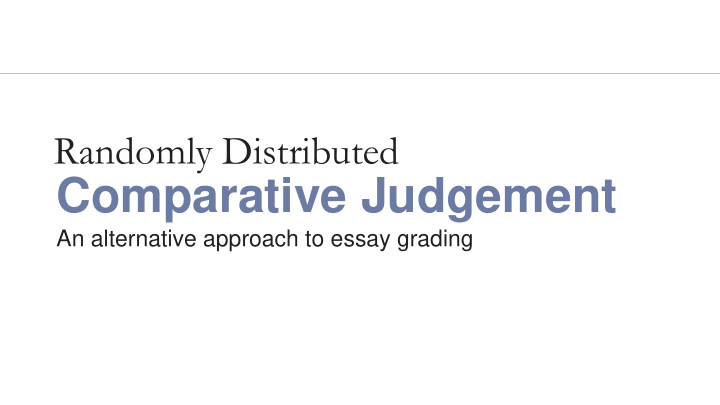



Randomly Distributed Comparative Judgement An alternative approach to essay grading
MEET THE research team Dr. Cox Mornie Sims Dr. Eckstein Dr. Hartshorn Judson Hart Dr. Wilcox
Col Reliability consistency d Validity authenticity War
reliability? 1880s – inconsistent scoring reliability → ? validity indirect → MC testing component skills highly reliable strongly correlated with writing grades
validity? 1961 Study – opposite effect spurious correlations (# of bathrooms) teacher focus on component skills (Braddock, et al.) writing → active skill MC → passive, undue attention to less important features
direct RELIABILITY IN writing assessme Rubrics Training nt Double-rating Adjudication MFRM
THE rubric METHOD • Absolute judgment • External standard • Training/calibration
comparativ RANDOMLY DISTRIBUTED e judgment • Comparison • Relative choice • Instinctual skill
“There is no absolute judgment. All judgments are comparisons of one thing to another.” [Donald Laming]
RDCJ RR & Implicit comparison Explicit comparison Training for consensus Minimizes training Unavoidable bias Minimizes bias MFRM Inherent algorithm
HOW IT works.
demo nomoremarking.com https://www.nomoremarking.com/demo1
test it! nomoremarking.com https://www.nomoremarking.com/judges/reg/sLRRwmGAe65Wx3mbv
CJ CJ eliminates common scoring biases Strictness vs leniency Central or extreme tendencies Additionally RATIONALE it is less cognitively demanding/time consuming per judgment Steedle and Ferrara, 2016 it requires less training evidence suggests that it is highly accurate (Gill & Bramley, 2008)
comparative judgment …is a promising alternative, BUT is it… Reliable and Practical? and Can we trust the results?
research question How does traditional rubric rating compare with MFRM (many facet Rasch model) and RDCJ (randomly distributed Comparative Judgment) in an ESL setting in terms of reliability , validity , and practicality ?
Rater Group A Rater Group B Raters 4 Novice 4 Novice 4 Experienced 4 Experienced Analysis ANCOVA Essay Set 1 Essay Set 2 Essays 20% I. Samples t Tests (n=37) (n=38) Spearman's Rho Randomly Distributed Comparative Rubric Rating (RR) Ratings Judgment (RDCJ) MFRM Fair Average RDCJ True Score Figure 2. Study design to compare traditional rubric rating (RR) to multi-facet Rasch modeling (MFRM) and randomly distributed comparative judgment (RDCJ). Analysis of variance (ANOVA) run to test for effects on rating time and Spearman’s rho used to correlate between MFRM adjusted fair average, the study rubric rating fair averages, and RDCJ true scores to show evidence of validity.
SELECTED Essays
Rubric Ratin g WITHOUT MFRM
Evidence RELIABILITY & VALIDITY
Practicality DATA
d COHEN’S
t TESTS
Covarianc ANALYSIS OF e
Covarianc ANALYSIS OF e
essay LENGTH & RATINGS
CJ APPLICATIONS Especially suited to productive tasks Portfolios, essays, short answer Barkhaoui, 2016 Many subject areas Bramley, 2015 English, ESL, History, Geography Christodolou, 2016 Interesting Applications Mathematical problem solving Heldsinger & Humphrey, Peer Assessment (highly 2013 reliable & correlated with expert ratings)
SUBJECT Areas
Peer ASSESSMENT
Peer ASSESSMENT (cont)
calibrate d EXEMPLARS
Comparative Judgment thank you! Mornie Sims Dr. Grant Eckstein eslmornie@gmail.com grant_eckstein@byu.edu Dr. Troy Cox Dr. K. James Hartshorn Troy_cox@byu.edu James_Hartshorn@byu.edu Dr. Matthew Wilcox Judson Hart wilcoxmp@byu.edu hatuhart@gmail.com
essay prompt Identify one improvement that would make your city a better place to live for people your age and explain why people your age would benefit from this change. Use specific reasons and examples to support your opinion and describe the potential immediate and long-term consequences of this improvement. You have 30 minutes to write your response.
Rubric STUDY
Recommend
More recommend